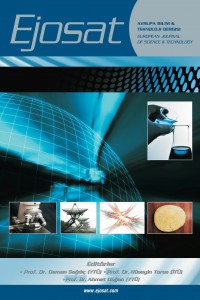Öz
Günümüzde ülkelerin gelişmişlik seviyelerinin en önemli göstergelerinden biri enerji tüketimleridir. Sosyal ve ekonomik kalkınmanın en önemli girdisi olan enerji, yaşam standardının artması ve sürdürülebilir kalkınma sağlanabilmesi için zorunlu ihtiyaçtır. Elektrik enerjisi kolay kullanımı, kolay taşınması ve temiz bir enerji olması nedeniyle en çok tercih edilen ve tüketilen enerji türlerinden biri olmuştur. Elektrik tüketimi nüfus, ekonomik büyüme ve gayri safi yurtiçi hâsıla gibi çeşitli sosyal ve ekonomik değişkenlerin yanı sıra sıcaklık, yağış ve nem gibi iklimsel değişkenlere de bağlı değişiklik göstermektedir. Isınma ve soğuma ihtiyacı için kullanılan elektriğin, elektrik tüketimindeki etkisi büyüktür. Hava şartları elektrik tüketiminde artış ve azalışa neden olurken, etkisi en yüksek meteorolojik değişken sıcaklıktır. Konfor sıcaklığı kabul edilen sıcaklık aralığından uzaklaşıldıkça elektrik tüketimi de artmaktadır. Çalışmada Türkiye elektrik tüketiminin sıcaklık ile ilişkisi incelenmiştir. Aylık ve mevsimlik zaman periyodlarında tüketimin sıcaklık nedeniyle ne yönde ve ne kadar değiştiği araştırılmış, tüketim tahmin modeline sıcaklık girdi olarak eklenerek daha tutarlı tüketim tahmini yapabilmek amaçlanmıştır. Çalışma kapsamında Yapay Sinir Ağı yöntemi ve Levenberg-Marquardt geriye yayılma algoritması ile modellenen veri grupları kullanılarak kısa dönemli elektrik tüketim tahmini yapılmıştır. Çalışma aralığı olarak Ocak 2012-Kasım 2016 yılları belirlenmiştir. Bu yıllara ait Türkiye toplam tüketim verisi ve sıcaklık verisi kullanılmıştır. Sıcaklık verisi, tüketim miktarına göre ağırlıklandırılmış ortalama ile üretilmiştir. Türkiye tüketiminde en çok paya sahip 12 ilin sıcaklıkları, tüketim oranlarına göre ağırlıklandırılmıştır.
Anahtar Kelimeler
Kaynakça
- A. M. Ashraful, H. H. Masjuki, M. A. Kalam, I. M. Rizwanul Fattah, S. Imtenan, S. A. Shahir and H. M. Mobarak, "Production and comparison of fuel properties, engine performance, and emission characteristics of biodiesel from various non-edible vegetable oils: A review," Energy Conversion and Management, vol. 80, no. 202-228, 2014.
- A. S. Khwaja, X. Zhang,, A. Anpalagan and B. Venkatesh, “Boosted neural networks for improved short-term electric load forecasting,” Electric Power Systems Research, p. 431–437, 2017.
- A. Azadeh, S. F. Ghaderi and S. Sohrabkhani, "Annual Electricity Consumption Forecasting By Neural Network İn High Energy Consuming İndustrial Sectors of Iran," Energy Conversion and Management, no. 49, p. 2272–2278, 2008.
- EPDK, "Elektrik Piyasası 2015 Yılı Piyasa Gelişim Raporu," T.C. Enerji Piyasası Düzenleme Kurumu (EPDK), Ankara, Türkiye. 2016
- E. Almeshaiei and H. Soltan, "A methodology for Electric Power Load Forecasting," Alexandria Engineering Journal, no. 50, p. 137–144, 2011. EPDK, "Elektrik Piyasası 2015 Yılı Piyasa Gelişim Raporu," T.C. Enerji Piyasası Düzenleme Kurumu (EPDK), Ankara, Türkiye. 2016.
- G. Aneiros, J. Vilar and P. Raña, "Short-term forecast of daily curves of electricity demand and price," Electrical Power and Energy Systems, no. 80, pp. 96-108, 2016.
- H. Toros, R. Ayaz, A. Ajder, A. Durusu and H. Yıldırım, "Online Load Shifting Of Electricity Production-Consumption For Reducing Environmental Hazard," European Journal of Science and Technology (EJOSAT), vol. 1, no. 2, pp. 39-42, 2013.
- J. Boylan, “Toward a More Precise Definition of Forecastabilitiy," Business Forecasting, SAS Institute Inc., Cary, North Carolina, USA.
- J. C. Lam, "Climatic and economic influences on residential electricity consumption," Energy Conversion and Management, vol. 39, no. 7, pp. 623-629, 1998.
- J. Moral-Carcedo and J. PerezüGarcia, "Temperature effects on firms’ electricity demand: An analysis of sectorial differences in Spain," Applied Energy, no. 142, p. 407–425, 2015.
- L. Friedrich and A. Afshari, "Short-term forecasting of the Abu Dhabi electricity load using," Energy Procedia, no. 75, pp. 3014-3026, 2015.
- S. Yıldız, "Türkiye Elektrik Piyasası Kısa Dönemli Referans Fiyat Tahmini,” İTÜ, Enerji Enstitüsü, İstanbul, 2015.
Prediction of Short-Term Electricity Consumption by Artificial Neural Networks Using Temperature Variables
Öz
Anahtar Kelimeler
Temperature Electricity Consumption Annual Neurol Network(ANN) Model
Kaynakça
- A. M. Ashraful, H. H. Masjuki, M. A. Kalam, I. M. Rizwanul Fattah, S. Imtenan, S. A. Shahir and H. M. Mobarak, "Production and comparison of fuel properties, engine performance, and emission characteristics of biodiesel from various non-edible vegetable oils: A review," Energy Conversion and Management, vol. 80, no. 202-228, 2014.
- A. S. Khwaja, X. Zhang,, A. Anpalagan and B. Venkatesh, “Boosted neural networks for improved short-term electric load forecasting,” Electric Power Systems Research, p. 431–437, 2017.
- A. Azadeh, S. F. Ghaderi and S. Sohrabkhani, "Annual Electricity Consumption Forecasting By Neural Network İn High Energy Consuming İndustrial Sectors of Iran," Energy Conversion and Management, no. 49, p. 2272–2278, 2008.
- EPDK, "Elektrik Piyasası 2015 Yılı Piyasa Gelişim Raporu," T.C. Enerji Piyasası Düzenleme Kurumu (EPDK), Ankara, Türkiye. 2016
- E. Almeshaiei and H. Soltan, "A methodology for Electric Power Load Forecasting," Alexandria Engineering Journal, no. 50, p. 137–144, 2011. EPDK, "Elektrik Piyasası 2015 Yılı Piyasa Gelişim Raporu," T.C. Enerji Piyasası Düzenleme Kurumu (EPDK), Ankara, Türkiye. 2016.
- G. Aneiros, J. Vilar and P. Raña, "Short-term forecast of daily curves of electricity demand and price," Electrical Power and Energy Systems, no. 80, pp. 96-108, 2016.
- H. Toros, R. Ayaz, A. Ajder, A. Durusu and H. Yıldırım, "Online Load Shifting Of Electricity Production-Consumption For Reducing Environmental Hazard," European Journal of Science and Technology (EJOSAT), vol. 1, no. 2, pp. 39-42, 2013.
- J. Boylan, “Toward a More Precise Definition of Forecastabilitiy," Business Forecasting, SAS Institute Inc., Cary, North Carolina, USA.
- J. C. Lam, "Climatic and economic influences on residential electricity consumption," Energy Conversion and Management, vol. 39, no. 7, pp. 623-629, 1998.
- J. Moral-Carcedo and J. PerezüGarcia, "Temperature effects on firms’ electricity demand: An analysis of sectorial differences in Spain," Applied Energy, no. 142, p. 407–425, 2015.
- L. Friedrich and A. Afshari, "Short-term forecasting of the Abu Dhabi electricity load using," Energy Procedia, no. 75, pp. 3014-3026, 2015.
- S. Yıldız, "Türkiye Elektrik Piyasası Kısa Dönemli Referans Fiyat Tahmini,” İTÜ, Enerji Enstitüsü, İstanbul, 2015.
Ayrıntılar
| Birincil Dil | İngilizce |
|---|---|
| Konular | Mühendislik |
| Bölüm | Makaleler |
| Yazarlar | |
| Yayımlanma Tarihi | 31 Aralık 2018 |
| Yayımlandığı Sayı | Yıl 2018 Sayı: 14 |


